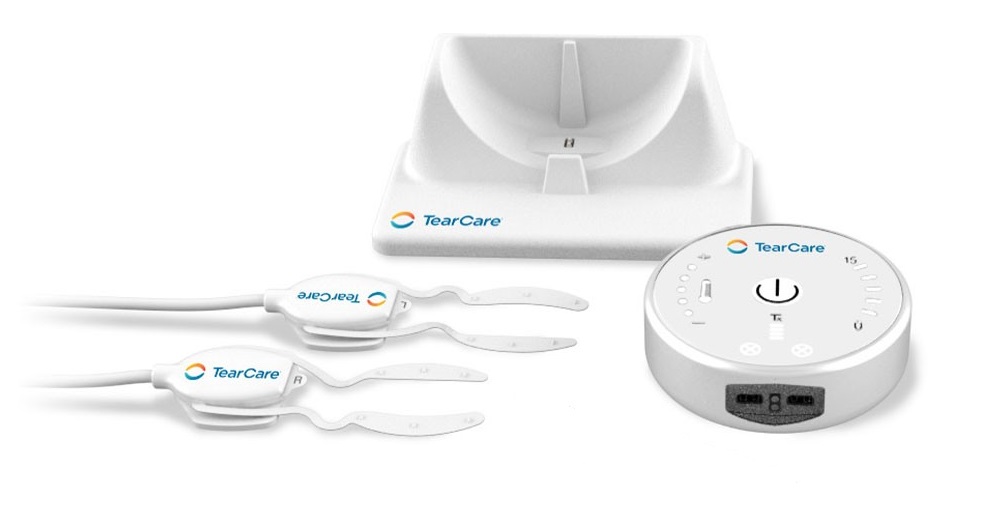Dry Eye Disease (DED) occurs when your tears are not sufficient to keep the front surface of the eye lubricated properly. If you do not produce enough tears, or if the composition of your tears is not balanced, this results in your eyes becoming dry which can cause fluctuating vision and often pain.

Patients often feel their problem cannot be “dry eyes” because their eyes overflow with tears. Healthy tears are composed of mucus, oil, water and oxygen, and the absence of any one of these components may lead to tears that do not do their job. Excessive watery tears try to compensate. These reflex tears do not lubricate sufficiently and may actually aggravate the problem.
The symptoms of Dry Eye Disease (DED) can be a problem for all ages, but it is more common as we get older. It occurs when your tears are not sufficient to keep the front surface of the eye, your cornea, well lubricated. The cornea needs constant lubrication by tears to stay healthy. “Tears are made up of three components: an outer layer of oil, a middle layer of water, and an inner layer of mucus.” explains Dr. Foster “If you do not produce enough tears, or if the composition of your tears is not balanced, your eyes will not be properly lubricated. The result may be blurry vision, scratchy, itchy eyes, and even pain.”
The Eye Associates is proud to announce that they have been certified by TearLab as an Accredited Dry Eye Center of Excellence. The doctors at The Eye Associates have extensive experience in the diagnosis and treatment of Dry Eye Disease, and being certified demonstrates our expertise and dedication to providing the highest quality of dry eye care using advanced ophthalmic diagnostic techniques and treatments.

There can be many causes of Dry Eye Disease (DED) and it may take some time to find the right course of action that will work for your eyes. The following are some of the most common causes:
Aging
Aging is one of the most common causes of dry eyes because tear production tends to diminish as you get older.
Environment
Hot, dry, and windy weather; heaters and air conditioners; and high altitudes increase the evaporation of tears. Ceiling fans are another common factor.
Computer Use
Computer users have a tendency to “stare” at a screen for long periods without blinking. This insufficient blinking pattern is often the cause for dry eyes in increasingly younger people. Dry eyes are one of the reasons that we often recommend the use of computer eyeglasses.
Poor Lid Function
As you blink, your eyelids continuously spread a thin film of tears over the surface of your eye. Problems with eyelids, such as out-turning of the lids (ectropion) or an in-turning of the lids (entropion) can contribute to Dry Eye Disease.
Contact Lenses
Long term contact lens wear can negatively affect your tear production. If you are a contact lens wearer, you should ask your eye doctor about some brands of contact lenses that work better for dry eye patients.
Smoking
If you need yet another reason to stop smoking, add Dry Eye Disease to the list. Recent studies have suggested that smoking can greatly increase your risk for dry eyes.
Medical Conditions
Hormonal changes, especially in women, can cause problems with dryness. Also, patients suffering from thyroid disease, rheumatoid arthritis, psoriasis, eczema, Sjogren’s syndrome, lupus, scleroderma, and other systemic conditions often experience Dry Eye Disease. In addition, blepharitis, an inflammation of the eyelids, is a common cause.
Medications
Diuretics, allergy medication, antihistamines, and many other common medications can all produce dry eye symptoms. Also, a lack of some vitamins may increase dryness.
Thanks to new technology, dry eyes can now be treated in ways never before available. One of the latest diagnostic tools is The TearLab Osmolarity System, which measures tear osmolarity by taking a small sample of the patient’s tears to see how “dry” they really are.
Treatment is then prescribed based on the measurements from the TearLab. Treatments range from Omega 3 supplements, tear replacement drops, punctal plugs, anti- inflammatory drops, oral antibiotics, prescription strength artificial tears, eyelid correction surgery and amniotic membrane, just to name a few. “This analysis of a patient’s tear fluids has set a new ‘standard of care’ for those who suffer from Dry Eye Disease,” commented Dry Eye Specialist, Dr. Scott Han. “We are so pleased to be a certified Dry Eye Center and offer our patients the latest treatments available.
One of the causes for DED is eyelid inflammation, and the IPL is a great way to gently and effectively treat that. It targets the root cause for inflammation, abnormal blood vessels. The body’s natural reaction to IPL is to remove these abnormal vessels to heal the inflammation. The IPL is FDA approved for the treatment of dry eye disease due to meibomian gland dysfunction (MGD).
Meibomian Gland Dysfunction (MGD) can be another cause of DED. Studies show that 86% of dry eye patients are affected by MGD. The LipiFlow is a safe, drug-free way to treat meibomian gland obstructions while protecting the delicate structure of the eye. And it is so comfortable that many patients actually fall asleep during the 12-minute treatment.

TearCare is a single-use treatment tool that applies heat to the eyelids to remove blockage associated with meibomian gland dysfunction. It is an in-office procedure designed to target the underlying cause of evaporative dry eye.
The Eye Associates is one of the few practices that is equipped to offer serum tear treatment for patients. Since artificial tears lack the biologically active elements found in our natural tears, specially formulated autologous serum tear eye drops, made from components derived from one’s own body, have a healing effect not found in manufactured tears.
Scleral lenses are oversized gas permeable contact lenses that basically trap fluids behind the lens to add moisture to the eye. Many times these lenses are used in conjunction with other dry eye treatments.
Check out the video below with a patient talking about her experience with scleral lenses.
Amniotic membrane tissue contains specialized proteins and growth factors that diminish inflammation, prevent drying, aid tear stability and accelerate healing.
Blepharitis is a chronic, inflammatory disease of the eyelids. This inflammation can adversely affect the tear glands, slowing down tear production. We now offer a painless, in-office lid exfoliation that only takes 6 – 8 minutes. Just as you need your teeth cleaned a couple of times a year, we recommend you repeat lid exfoliation every 4-6 months.
Restasis, Xiidra and Cequa are FDA approved prescription eye drops that treat inflammation in the eye. They have proved to be successful in helping some patients with moderate to severe dry eye conditions.
Punctual plugs are another option. The doctor places temporary plugs in the upper and/or lower tear drainage canals. This helps recycle the lubricating tear film on the eyes’ surface by reducing tear drainage.
An Eye Hydrating Compress is a heated moist compress that is placed over your resting eyes to improve oil gland production in order to expel bacteria, stabilize tear film and slow tear evaporation. Those with a mild to moderate dry eye condition find this natural treatment soothing and beneficial. These masks can be found at any of The Optical Gallery locations at The Eye Associates.

The 3 Oasis Tears products:
One of the artificial tears that we often recommend is Oasis Tears. Oasis is an effective medical grade lubricating artificial tear and is the only patented viscoadaptive lubrication eye drop. Unlike most tears, it combines glycerin with plant-based sodium hyaluronate, which coats and recoats the surface of the eye for longer periods of time than most other drops. All three products, Oasis Tears PF multi-use vials, Oasis Tears PF multi-dose bottles and Oasis Tears Plus PF multi-use vials offer instant comfort as well as longer lasting comfort.
What is the Difference Between Oasis Tears PF and Oasis Tears Plus PF?
Oasis Tears has 0.15% concentration of high molecular weight sodium hyaluronate. Oasis Tears Plus has 0.3% concentration of high molecular weight sodium hyaluronate. Oasis Tears Plus is sometimes termed as a gel tear because of its thicker nature. Neither are sold at drugstores.
Both are preservative-free and as long as the bottle or the vial is not compromised, it is good for 90 days.
NOTE: Most pharmacies do not carry this medical grade teardrop. For your convenience, we sell Oasis in all of our offices.
Lid hygiene is very important in the management of Dry Eye Disease (DED) so lid scrubs are often recommended. By using lid scrubs, patients are able to better remove debris and bacteria, and stimulate meibomian gland secretions; all of which help with DED. There are many brands available over the counter so it’s important to try a few out to see which type works best for you.

As we age, many times our skin will sag, especially around the eyelids. This may cause the lids to not close properly and allow for the evaporation of the tears. Our Fellowship Trained Oculofacial Surgeon, Dr. Michael Mercandetti can evaluate your eyes to see if surgery is the answer to your dry eye discomfort.